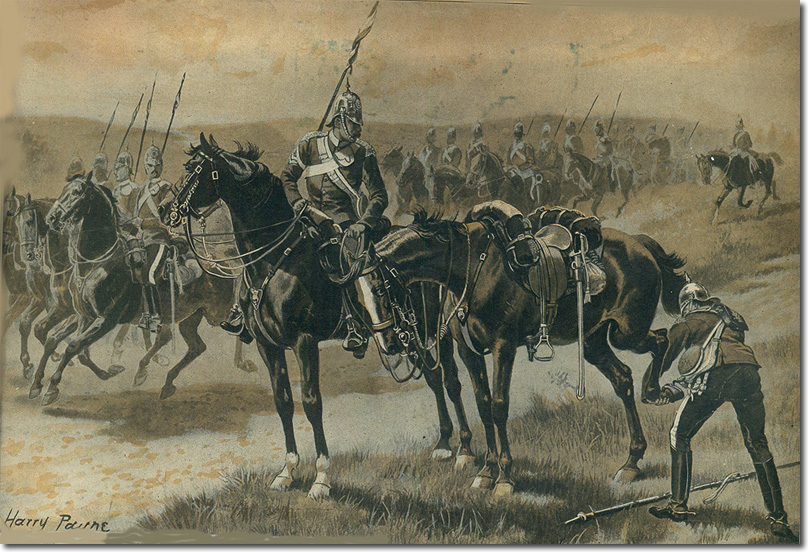|
|

 |
|
Harry Payne's monochrome illustration of the Queen's Bays on the march has much detail which can be trusted because he was a keen observer, and was a serving Yeomanry soldier himself. The painting is dated 1897 when the regiment was stationed at Aldershot. They had been in India from 1886 to 1895 and in Egypt from 1895 to 1896. The uniform they are wearing is a form of undress in that the tunic is a scarlet serge frock with buff collar and steel shoulder chains. The chains which are like chain mail were worn by the regiment on their khaki uniforms in India. Thy weren't officially permitted for home service until 1898, and the Bays may have been the first cavalry regiment to wear them in England.
Perhaps the most striking aspect of the picture is the fact that they are carrying lances. In 1892 it was decided to equip the front ranks of the dragoon guard regiments with lances, 9 foot long and made of ash or bamboo. The pennant on the end below the steel tip, was red over white, the colours of Poland, the country that inspired the adoption of lancers in European 19th century armies. This was allowed to fly free on ceremonial occasions but on the march and on campaign was wrapped around the shaft and secured. The lance is supported in small buckets attached to both stirrups so that it can be carried either side. The mounted corporal has his lance on the right side with a white strap looped around his upper arm. The equipment carried by the troopers includes a canvas haversack for food, and a water bottle, slung over the right shoulder. The ammunition pouch, which can be seen on the back of the man tending to his horse's hoof, is of black leather with a badge in the middle. This is indistinct but another illustration by Simkin clearly shows a crown badge. The pouch is slung on the left shoulder with a white leather belt. A small white leather pouch is seen here attached to the front. When the cavalry were issued with percussion carbines they had such a pouch for the caps, but with the introduction of cartridges and the Martini Henri carbine in 1878 there was no need for them. Perhaps they were simply for extra rounds and easy access. They have swords attached to the saddle, a change made in 1891, and boots attached to the front of the saddle for dismounted duty. There is also the valise for the cloak at the back, and a rolled blanket at the front. Their helmets have had the black plume removed to prevent spoiling. |
Armed Forces | Art and Culture | Articles | Biographies | Colonies | Discussion | Glossary | Home | Library | Links | Map Room | Sources and Media | Science and Technology | Search | Student Zone | Timelines | TV & Film | Wargames Library | Search | TV & Film | Wargames
